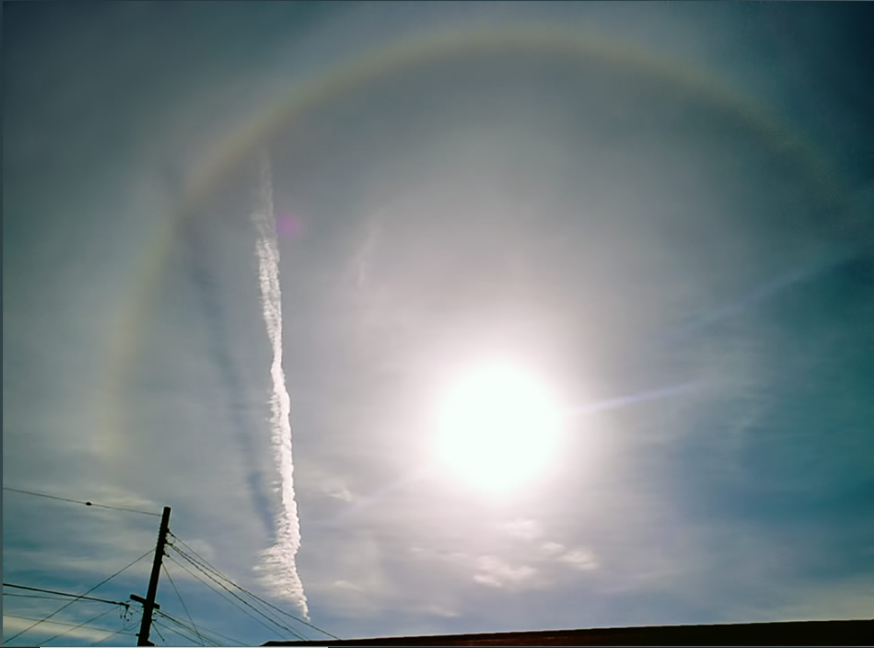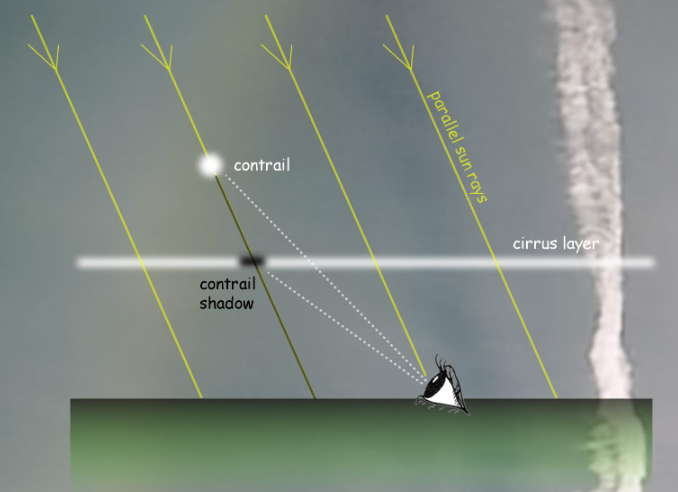Contrail Shadow & Halo - OPOD
Contrail Shadow & Halo: A Fascinating Atmospheric Phenomenon
Contrails, also known as condensation trails, are a common sight in the sky. These long, white lines left behind by aircraft are formed when hot exhaust gases mix with the cold air at high altitudes. However, there is more to contrails than meets the eye. In this article, we will explore a captivating atmospheric optics phenomenon: the contrail shadow and halo.
The Intriguing Twisted Contrail and its Shadow
One striking feature of the contrail shadow is its twisted appearance. As the contrail casts its shadow onto a thin sheet of cirrus cloud, an extraordinary visual effect occurs. The shadow seems to follow a meandering path, defying our intuition about how shadows should behave.
Shadows that Challenge Perception
Contrail shadows often confuse observers due to their counterintuitive nature. It is natural to assume that the contrail lies beneath the cirrus layer, suggesting that the sun is shining upwards. However, shadows are always cast downwards. Analyzing the corresponding schematic of the image, we can see that the contrail appears to the left of the sun ray reaching the eye, indicating that the shadow is actually cast in the opposite direction.
Deciphering the Puzzle
Upon closer inspection of the image, an intriguing puzzle emerges. The contrail and its shadow appear to merge at the lower left corner. This merging could indicate one of two possibilities: either the aircraft is descending, or the cirrus layer itself is tilted. This ambiguity adds an extra layer of fascination to the phenomenon, inviting us to ponder the dynamics of atmospheric conditions and their impact on the visual spectacle above us.
Exploring the 22 Degree Halo
In addition to the enigmatic contrail shadow, another atmospheric optics phenomenon comes into play: the 22 degree halo. This optical phenomenon occurs when sunlight passes through ice crystals within the cirrus cloud. The ice crystals act as prisms, bending and refracting the light, resulting in a circular halo around the sun. The 22 degree halo gets its name from the angle at which the light is bent within the ice crystals.
Unveiling Nature's Artistry
The combination of the contrail shadow and the 22 degree halo creates a captivating interplay between light and atmospheric elements. It is a testament to the intricate beauty of nature's artistry, reminding us of the complexity and wonder that exists above us in the sky.
The Intricacies of Contrail Shadows
Contrail shadows are not only visually intriguing, but they also provide valuable insights into atmospheric dynamics. By studying these shadows, scientists can gain a better understanding of how air currents and cloud formations interact with contrails. This knowledge can contribute to advancements in meteorology and aviation, helping to improve weather forecasting models and aircraft efficiency.
The Role of Perspective
Perspective plays a crucial role in perceiving contrail shadows. The angle at which the observer views the contrail and its shadow can significantly influence their appearance. Depending on the observer's position relative to the sun, the length, shape, and intensity of the shadow may vary. This variability adds an element of unpredictability to the phenomenon, making each sighting a unique experience.
Capturing the Beauty
Photographers and sky enthusiasts alike often find themselves captivated by the ethereal beauty of contrail shadows and halos. These phenomena provide a rich canvas for artistic expression, with each image capturing a fleeting moment in the ever-changing tapestry of the sky. From professional photographers to amateur sky gazers, many have dedicated themselves to capturing these mesmerizing atmospheric displays.
Conclusion
Contrail shadows and halos are awe-inspiring atmospheric optics phenomena that remind us of the intricacies and wonders of our atmosphere. They challenge our perception, spark curiosity, and invite us to appreciate the beauty of nature's interplay with light and clouds. Next time you spot a contrail in the sky, take a moment to observe its shadow and marvel at the hidden complexities unfolding above us.

Contrail, Shadow, Halo
Sighted by Michael-Leonard Creditor
The peculiarly twisted contrail casts its shadow onto a thin sheet of cirrus cloud. Ice crystals in the same cirrus produce a 22 degree halo.
Image ©Michael-Leonard Creditor

Contrail shadows run counter to intuition. There is a strong feeling that the contrail is below the cirrus layer. That implies that the sun is shining upwards.
Shadows are always cast downwards. The schematic corresponding to the image shows the contrail appearing to the left of the sun ray reaching the eye.
The contrail shadow is further left.
There is a puzzle in the picture. The contrail merges with its shadow at lower left. The aircraft is either descending or the cirrus layer is tilted.
Note: this article has been automatically converted from the old site and may not appear as intended. You can find the original article here.
Reference Atmospheric Optics
If you use any of the definitions, information, or data presented on Atmospheric Optics, please copy the link or reference below to properly credit us as the reference source. Thank you!
-
<a href="https://atoptics.co.uk/blog/contrail-shadow-halo-opod/">Contrail Shadow & Halo - OPOD</a>
-
"Contrail Shadow & Halo - OPOD". Atmospheric Optics. Accessed on November 26, 2024. https://atoptics.co.uk/blog/contrail-shadow-halo-opod/.
-
"Contrail Shadow & Halo - OPOD". Atmospheric Optics, https://atoptics.co.uk/blog/contrail-shadow-halo-opod/. Accessed 26 November, 2024
-
Contrail Shadow & Halo - OPOD. Atmospheric Optics. Retrieved from https://atoptics.co.uk/blog/contrail-shadow-halo-opod/.